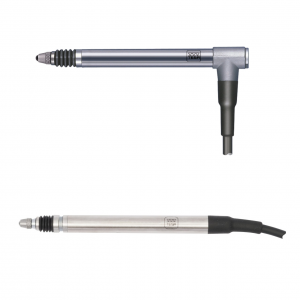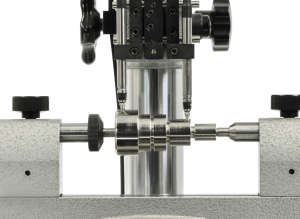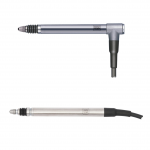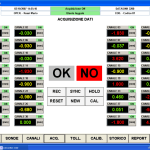
I LVDT linear transducers allow precision measurements on mechanical parts or on any object that can be measured with a contact probe.
Combined with special signal amplifiers they allow the measurement of dimensional characteristics (thicknesses, widths, positions, heights, diameters, ovality) and geometric (flatness, parallelism, perpendicularity, oscillation, eccentricity and coaxiality) with millesimal precision even on complex mechanical parts.
LVDT transducers with spring drive system (with fixed mechanical preload) or LVDT linear transducers with pneumatic drive particularly suitable for automatic measuring systems.
Some families of LVDT probes can be made with a vacuum-based displacement mechanism.
Transducers with radial cable exit, with axial cable exit or with quick connection and disconnection systems are possible.
RODER manufactures complete "turnkey" systems consisting of LVDT probes, amplifiers and electronic controllers, data acquisition systems, software for statistical and mechanical control specially designed.
RODER measurement systems find applications in many industrial sectors: precision mechanics, sheet metal working, plastic moulding, electro-medical, metallurgical and iron and steel.
Applications of LVDT transducers
Typical applications of measurement systems based on LVDT transducers are related to the measurement of mechanical parts, produced in plastic materials, in the glass sector, in the deformation processing sector.
Dimensional and geometric measurements and checks on stamped and cut parts

The LVDT probes, combined with the MODULCHECK systems of RODER production, allow the measurement in rapid times and directly in the production line of the flatness of molded, sliced, laminated or die-cast parts. The flatness measurement is carried out with a sensor matrix capable of detecting differences compared to a certified calibration master. The test result is a mapping of the verified areas with the relative numerical value of deviation from the ideal shape.
A very intuitive graphic presentation allows you to quickly and reliably determine the areas of non-compliance. All the data obtained can be used for statistical calculations (Sigma, Cp, Cpk, Cm, Cmk) or for the realization of control cards (XS, XR, process trend, population distribution).
Shape checks on large particulates

The LVDT linear transducers, combined with RODER production MODULCHECK systems, allow the shape control of objects of any size and material. The shape check is carried out by comparison with a reference master and all the differences are highlighted quickly and intuitively. It is possible to generate signals of out of tolerance or of partial non-conformity of the product. The system can also be installed in robotic control areas and unattended automatic control benches. In this configuration, all verification operations can be controlled directly by a PLC or an automatic production system.
Oscillation and eccentricity measurements on rotating parts

LVDT probes, combined with MODULCHECK systems produced by RODER, allows the determination of geometric characteristics of parts subjected to rotation on tailstocks. It is thus possible to measure diameters, ovalizations and oscillations but also roundness, cylindricity and data of the radial profile of the object (important in applications such as the measurement of camshafts). The measurement can also be acquired by measuring machines specially developed for this type of control in the metrological laboratory or in the production line (3D measuring machines, profilometers, optical machines).
Common characteristics of the systems proposed by RODER

- Excellent repeatability, durability and longevity.
- All LVDT RODER probes are mounted on ball bearings, except for miniature axial probes.
- The ball bearing guide is highly insensitive to the radial forces exerted on the measuring rod. An anti-rotation device ensures perfect movement of the mechanical guide system.
- The axial probe guides are highly protected against the penetration of liquids (oil) or solids (dust) through protective elastomeric quality bellows.
- The inserts (measuring inserts) can be replaced or replaced. A wide choice of geometric shapes and sizes is available.
- The measuring force can be adjusted by changing the spring, depending on the probe model.
- Diameter of the probe housing of 8 mm. It can be blocked over its entire length.
- Degree of protection IP65 according to IEC 60529.
- Wide range of accessories, including measuring inserts, spring sets, etc.
- LVDT probes compatible with measuring equipment from other manufacturers available on request.
RODER offers a complete family of LVDT sensors (analog electronic probes) and dedicated measuring instruments for the most demanding applications.
Standard probes LVDT RODER
Standard probes, also known as half bridge probes, operate according to the electrical principle of magnetic coupling. LVDT probes can be used in combination with measuring instruments from other manufacturers, to obtain a complete range of measurements and geometric measurements.
These probes are known as LVDT (Linear Variable Differential Transformer) probes. All RODER electronic probes can be used both with manual instruments, internal or external, or in combination with other typical measuring instruments and supports.
RODER is able to supply axial probes with linear displacement of the measuring stem, angular probes with tilting lever youparallel guided waves, specially designed for multi-dimension devices and any other in-process control equipment, thus saving many assembly components, which, with very few exceptions, essentially perform comparative measurements.
On the basis of a main master, which can be a measuring standard, a calibration ring or any other workpiece accepted as such, different dimensions of the test piece are compared.
All measurements are carried out with high precision and repeatability and allow for real-time product and process certification.
What is an LVDT Linear Transducer?
LVDT stands for Linear Variable Differential Transformers. It is a type of electromechanical transducer capable of converting the rectilinear motion of an object to which it is mechanically coupled into a corresponding electrical signal. LVDT linear position sensors can measure movements from a few millionths of a millimeter up to several millimetres.
The internal structure of the LVDT sensor consists of a primary winding centered between a pair of secondary windings, symmetrically spaced from the primary. The coils are wound on a single thermally stable support, encapsulated against humidity, wrapped in a high permeability magnetic shield, and then fixed in a cylindrical stainless steel housing. This coil assembly is usually the stationary element of the position sensor.
The moving element of an LVDT is a separate tubular reinforcement made of magnetically permeable material. This is called the core, which is free to move axially within the hollow hole of the coil and mechanically coupled to the object whose position is being measured. During operation, the primary winding of the LVDT is excited by an alternating current of adequate amplitude and frequency, known as primary excitation.
The electrical output signal of the LVDT is the differential AC voltage between the two secondary windings, which varies with the axial position of the core inside the LVDT coil. Usually this AC output voltage is converted by suitable electronic circuits to high level DC voltage or current which is more convenient to use.
Why use an LVDT linear transducer?
Infinite resolution
Since an LVDT operates according to the principles of electromagnetic coupling in a totally analog system it can measure infinitely small variations in the position of the nucleus. This infinite resolution capability is limited only by noise in an LVDT signal conditioner and the resolution of the output display. These same factors give an LVDT its exceptional repeatability.
Repeatability of the zero point
The position of the central zero point of an LVDT is extremely stable and repeatable, even in its wide operating temperature range. This makes an LVDT work well as a reference position sensor in closed loop control systems and high performance servo balancing tools.
Fast dynamic response
The particular construction allows an LVDT to respond very quickly to changes in the position of the core. The dynamic response of an LVDT sensor itself is limited only by the inertial effects of the light core mass.
Absolute exit
An LVDT is an absolute output device, as opposed to an incremental output device. This means that in the event of a power failure, the position data sent by the LVDT will not be lost. When the measurement system is restarted, the output value of the LVDT will be the same as before before the power supply was interrupted.
Some examples of LVDT linear transducers

Il inductive displacement transducer, Also known as LVDT extension, is an electromagnetic device used for the measurement of small displacements. The LVDT transducer has high precision and repeatability even in difficult working conditions and in the presence of contaminants.
Position and displacement transducers are robust and reliable, they ensure a long operating life. They offer measuring ranges between 0,2 and 10 mm. Economical, miniaturized, pressurized versions are available, with spring feeler, with or without incorporated electronics.
LVDT sensors with larger measuring ranges, customized construction forms and higher thermal excursion ranges are also possible.
Construction notes of LVDT linear transducers
The transducer is made by means of a tube composed of three windings arranged with parallel axes and with a movable ferromagnetic cylindrical core inside. The central winding is said packaging and the other two secondary: the primary one is connected to an AC voltage generator, the output voltage is measured at the ends of the secondary ones.
When the core is in the center, the voltage induced on the secondary windings, since these windings are wound in a discordant direction, is equal but opposite, so that the measured voltage signal is practically zero. As the core moves, however, the mutual inductances change, and depending on whether it moves to the left or to the right, the inductive coupling with the secondary respectively on the left or right will be greater. Consequently, the output signal will vary proportionally to the displacement of the core.
LVDT transducer amplifiers
So-called is used to translate the LVDT output signal phase discriminating demodulators. These are electronic devices that allow you to extract the rms value of the voltage representing the displacement, and to interpret from which part of zero the displacement occurs. The best known of all uses a double Graetz bridge which rectifies the alternating signal coming from the secondary windings and makes the algebraic sum. Depending on the sign of the sum, it is possible to understand from which side of the zero the shift occurred.
LVDT is a very sensitive transducer capable of measuring displacements in the order of micrometer fractions. Depending on the power supply frequency of the primary and the mass of the core, there are cut-off frequencies of a few hundred hertz and therefore good dynamic responses to fast movements that vary over time.
Related items

LVDT measurement probes

Measurement and control software
